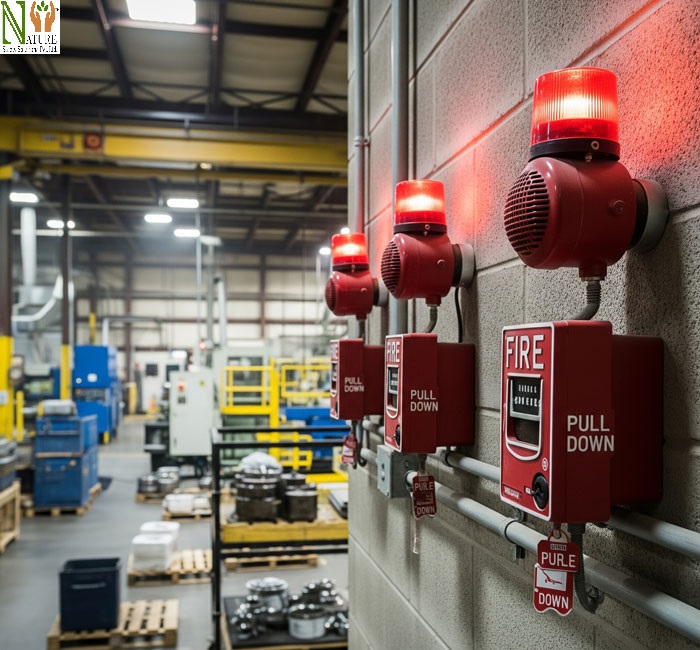Manufacturing plants are dynamic and essential parts of industry. They are filled with machinery, electrical systems, combustible materials, and chemicals. While they play a key role in production and economic growth, they also present significant fire hazards. In such high-risk environments, having a reliable fire alarm system is not a luxury—it is a necessity.
A well-installed and properly maintained fire alarm system can make the difference between a minor incident and a devastating disaster. Let’s explore the various ways fire alarms contribute to safety, protection, and efficiency in manufacturing facilities.

1. Early Detection Saves Lives and Property
The primary purpose of a fire alarm is to detect fires at their earliest stage. In a manufacturing facility, where fires can spread quickly due to oils, gases, electrical faults, or chemical reactions, even a few seconds can make a major difference.
- Early detection provides critical advantages:
- Employees can evacuate before flames spread.
- Emergency response teams are notified promptly.
- Fire suppression systems (like sprinklers or foam systems) can be activated early.
This timely response helps prevent injury, loss of life, and large-scale property damage. Fire alarms equipped with heat, smoke, and flame sensors ensure fast and accurate detection across all facility zones.
2. Ensuring Worker Safety in High-Risk Environments
Manufacturing plants are often noisy, with workers wearing ear protection and working in isolated sections. In such an environment, relying on visual cues alone is not enough.
- Fire alarm systems enhance safety by:
- Emitting loud sirens and flashing lights visible and audible even in high-noise zones.
- Offering voice alert systems that provide specific evacuation instructions.
- Guiding workers to safe exits through integrated emergency lighting systems.
By ensuring everyone is aware of a fire regardless of their location or job, fire alarms help maintain an orderly and efficient evacuation process. This reduces panic and confusion, especially in large, complex layouts.
3. Legal and Regulatory Compliance
Manufacturing units must adhere to strict fire safety codes enforced by organizations such as the Occupational Safety and Health Administration (OSHA), the National Fire Protection Association (NFPA), and local fire departments. These regulations mandate the installation and maintenance of fire alarm systems in industrial facilities.
- A compliant fire alarm system helps:
- Meet industry and government standards.
- Avoid legal penalties, fines, or forced shutdowns.
- Maintain eligibility for fire and liability insurance coverage.
- Pass periodic safety audits and inspections.
Staying compliant isn’t just about avoiding trouble—it’s also about showing your employees and partners that you take their safety seriously.
4. Protecting Expensive Equipment and Inventory
Industrial equipment and materials are often high in value and difficult to replace quickly. Fires can damage machinery, destroy raw materials, and ruin finished products, leading to major financial losses.
- Fire alarms help minimize these risks by:
- Activating suppression systems before the fire spreads.
- Alerting staff to shut down machines that may fuel the fire.
- Reducing damage to control systems, electronics, and stockrooms.
Preventing fire damage not only saves on repair and replacement costs but also reduces the length of downtime following an incident.
5. Maintaining Business Continuity
A fire incident can halt production for hours, days, or even weeks, depending on the damage. Lost productivity, missed delivery deadlines, and cancelled orders can all impact the bottom line.
- Fire alarm systems support continuity by:
- Enabling quick responses that limit operational disruption.
- Protecting key assets needed for rapid recovery.
- Ensuring accurate records of the incident for insurance and investigations.
The faster a facility can resume operations after a fire, the better its chances of retaining customer trust and avoiding revenue losses.
6. Integration with Modern Safety Technologies
Today’s fire alarm systems can integrate with other safety and automation systems for improved emergency response and overall efficiency.
Integrated systems can:
- Automatically unlock exit doors and gates during emergencies.
- Shut off HVAC systems to prevent smoke circulation.
- Alert security or emergency personnel with real-time data.
- Connect to sprinkler or chemical suppression systems for immediate action.
This interconnected approach makes response efforts faster, smarter, and more effective—especially in large or multi-building facilities.
7. Tailored Protection for Different Zones
Not all areas in a manufacturing plant face the same fire risks. Some spaces, like welding stations, boiler rooms, or paint booths, require special attention.
- Fire alarms can be customized to:
- Use heat, smoke, or gas detectors based on area needs.
- Tolerate harsh conditions like dust, vibration, or humidity.
- Reduce false alarms through intelligent sensor calibration.
- A flexible system ensures every part of the plant is protected without affecting normal operations.
8. Enhancing Employee Confidence and Safety Culture
When employees feel safe, they work better. A reliable fire alarm system boosts morale by showing that the company prioritizes their well-being.
It promotes:
- A proactive approach to workplace safety.
- Higher employee satisfaction and trust in management.
- Improved productivity due to reduced stress and distractions.
Fire safety awareness also builds a stronger organizational culture, where everyone is more alert and prepared for emergencies.
Also read:-
